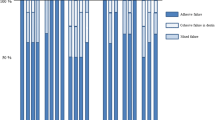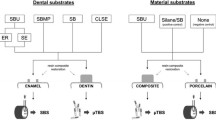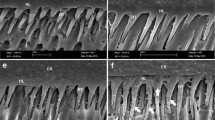Abstract
Objectives
This study aimed to evaluate the ultramorphological characteristics of tooth–resin interfaces and the bond strength (BS) of multimode adhesive systems to enamel and dentin.
Methods
Multimode adhesives (Scotchbond Universal (SBU) and All-Bond Universal) were tested in both self-etch and etch-and-rinse modes and compared to control groups (Optibond FL and Clearfil SE Bond (CSB)). Adhesives were applied to human molars and composite blocks were incrementally built up. Teeth were sectioned to obtain specimens for microtensile BS and TEM analysis. Specimens were tested after storage for either 24 h or 1 year. SEM analyses were performed to classify the failure pattern of beam specimens after BS testing.
Results
Etching increased the enamel BS of multimode adhesives; however, BS decreased after storage for 1 year. No significant differences in dentin BS were noted between multimode and control in either evaluation period. Storage for 1 year only reduced the dentin BS for SBU in self-etch mode. TEM analysis identified hybridization and interaction zones in dentin and enamel for all adhesives. Silver impregnation was detected on dentin–resin interfaces after storage of specimens for 1 year only with the SBU and CSB.
Conclusions
Storage for 1 year reduced enamel BS when adhesives are applied on etched surface; however, BS of multimode adhesives did not differ from those of the control group. In dentin, no significant difference was noted between the multimode and control group adhesives, regardless of etching mode.
Clinical relevance
In general, multimode adhesives showed similar behavior when compared to traditional adhesive techniques. Multimode adhesives are one-step self-etching adhesives that can also be used after enamel/dentin phosphoric acid etching, but each product may work better in specific conditions.


Similar content being viewed by others

References
Guba CJ, Cochran MA, Swartz ML (1994) The effects of varied etching time and etching solution viscosity on bond strength and enamel morphology. Oper Dent 19:146–153
Fanchi M, Breschi L (1995) Effects of acid-etching solutions on human enamel and dentin. Quintessence Int 26:431–435
EJ S Jr, Perdigão J, Heymann HO (1995) Bonding to enamel and dentin: a brief history and state of the art, 1995. Quintessence Int 26:95–110
Lopes GC, Thys DG, Klaus P, Oliveira GM, Widmer N (2007) Enamel acid etching: a review. Compend Contin Educ Dent 28:18–24
Pahlavan A, Dennison JB, Charbeneau GT (1976) Penetration of restorative resins into acid-etched human enamel. J Amer Dent Assoc 93:1170–1176
Low T, Lee KW, von Fraunhofer JA (1978) The adaptation of composite materials to etched enamel surfaces. J Oral Rehabil 5:349–355
Menezes LF, Chevitarese O (1994) Sealant and resin viscosity and their influence on the formation of resin tags. Angle Orthod 64:383–388
Browning WD, Brackett WW, Gilpatrick RO (2000) Two-year clinical comparison of a microfilled and a hybrid resin-based composite in non-carious class V lesions. Oper Dent 25:46–50
Ozgunaltay G, Onen A (2002) Three-year clinical evaluation of a resin modified glass-ionomer cement and a composite resin in non-carious class V lesions. J Oral Rehabil 29:1037–1041
Haller B (2013) Which self-etch bonding systems are suitable for which clinical indications? Quintessence Int 44:645–661
Mahn E, Rousson V, Heintze S (2015) Meta-analysis of the influence of bonding parameters on the clinical outcome of tooth-colored cervical restorations. J Adhes Dent 17:391–403
Peumans M, De Munck J, Van Landuyt KL, Poitevin A, Lambrechts P, Van Meerbeek B (2010) Eight-year clinical evaluation of a 2-step self-etch adhesive with and without selective enamel etching. Dent Mater 26:1176–1184
De Goes MF, Giannini M, Daronch M, Arrais CAG, Di Hipólito V, Rueggeberg FA (2007) Bond strength and monomer conversion of bonding agents mixed with restorative composites prior to light exposure. J Adhes 83:83–113
Sadek FT, Calheiros FC, Cardoso PE, Kawano Y, Tay F, Ferrari M (2008) Early and 24-hour bond strength and degree of conversion of etch-and-rinse and self-etch adhesives. Am J Dent 21:30–44
Albuquerque M, Pegoraro M, Mattei G, Reis A, Loguercio AD (2008) Effect of double-application or the application of a hydrophobic layer for improved efficacy of one-step self-etch systems in enamel and dentin. Oper Dent 33:564–570
Andrade e Silva SM, Carrilho MR, Marquezini Junior L, Garcia FC, Manso AP, Alves MC, de Carvalho RM (2009) Effect of an additional hydrophilic versus hydrophobic coat on the quality of dentinal sealing provided by two-step etch-and-rinse adhesives. J Appl Oral Sci 17:184–189.
Tay FR, Carvalho R, Sano H, Pashley DH (2000) Effect of smear layers on the bonding of a self-etching primer to dentin. J Adhes Dent 2:99–116
Tay FR, Pashley DH (2001) Aggressiveness of contemporary self-etching systems. I: Depth of penetration beyond dentin smear layers. Dent Mater 17:296–308
Tjäderhane L, Nascimento FD, Breschi L, Mazzoni A, Tersariol IL, Geraldeli S, Tezvergil-Mutluay A, Carrilho M, Carvalho RM, Tay FR, Pashley DH (2013) Strategies to prevent hydrolytic degradation of the hybrid layer—a review. Dent Mater 29:999–1011
Mazzoni A, Scaffa P, Carrilho M, Tjäderhane L, Di Lenarda R, Polimeni A, Tezvergil-Mutluay A, Tay FR, Pashley DH, Breschi L (2013) Effects of etch-and-rinse and self-etch adhesives on dentin MMP-2 and MMP-9. J Dent Res 92:82–86
Kalavacharla V, Lawson N, Ramp L, Burgess J (2015) Influence of etching protocol and silane treatment with a universal adhesive on lithium disilicate bond strength. Oper Dent 40:372–378
Marchesi G, Frassetto A, Mazzoni A, Apolonio F, Diolosa M, Cadenaro M, Di Lenarda R, Pashley DH, Tay F, Breschi L (2014) Adhesive performance of a multimode adhesive system: 1-year in vitro study. J Dent 42:603–612
Perdigão J, Kose C, Mena-Serrano AP, De Paula EA, Tay LY, Reis A, Loguercio AD (2014) A new universal simplified adhesive: 18-month clinical evaluation. Oper Dent 39:113–127
Wagner A, Wendler M, Petschelt A, Belli R, Lohbauer U (2014) Bonding performance of universal adhesives in different etching modes. J Dent 42:800–807
Kim JH, Chae SY, Lee Y, Han GJ, Cho BH (2015) Effects of multipurpose, universal adhesives on resin bonding to zirconia ceramics. Oper Dent 40:55–62
Kaaden C, Powers JM, Friedl KH, Schmalz G (2002) Bond strength of self-etching adhesives to dental hard tissues. Clinical Oral Investigation 6:155–160
Miyazaki M, Hinoura K, Honjo G, Onose H (2002) Effect of self-etching primer application method on enamel bond strength. Am J Dent 15:412–416
Kanemura N, Sano H, Tagami J (1999) Tensile bond strength to and SEM evaluation of ground and intact enamel surfaces. J Dent 27:523–530
Shinohara MS, Oliveira MT, Di Hipólito V, Giannini M, De Goes MF (2006) SEM analysis of the acid-etched enamel patterns promoted by acidic monomers and phosphoric acids. J Appl Oral Sci 14:427–435
Sadek FT, Monticelli F, Muench A, Ferrari M, Cardoso PE (2006) A novel method to obtain microtensile specimens minimizing cut flaws. J Biomed Mater Res B Appl Biomater 78:7–14
McLean D, Meyers E, Guillory V, Vandewalle K (2015) Enamel bond strength of new universal adhesive bonding agents. Oper Dent 40:410–417
Yoshida Y, Nagakane K, Fukuda R, Nakayama Y, Okazaki M, Shintani H, Inoue S, Tagawa Y, Suzuki K, De Munck J, Van Meerbeek B (2004) Comparative study on adhesive performance of functional monomers. J Dent Res 83:454–458
André CB, Gomes BPFA, Duque TM, Stipp RN, Chan DC, Ambrosano GM, Giannini M (2015) Dentin bond strength and antimicrobial activity evaluation of adhesive systems. J Dent 43:466–475
Van Landuyt KL, Snauwaert J, De Munck J, Peumans M, Yoshida Y, Poitevin A, Coutinho E, Suzuki K, Lambrechts P, Van Meerbeek B (2007) Systematic review of the chemical composition of contemporary dental adhesives. Biomaterials 28:3757–3785
Reis AF, Giannini M, Pereira PNR (2007) Long-term TEM analysis of the nanoleakage patterns in resin–dentin interfaces produced by different bonding strategies. Dent Mater 23:1164–1172
Yoshida Y, Van Meerbeek B, Nakayama Y, Snauwaert J, Hellemans L, Lambrechts P, Vanherle G, Wakasa K (2000) Evidence of chemical bonding at biomaterial-hard tissue interface. J Dent Res 79:709–714
Osorio R, Ceballos L, Tay F, Cabrerizo-Vilchez MA, Toledano M (2002) Effect of sodium hypochlorite on dentin bonding with a polyalkenoic acid-containing adhesive system. J Biomed Mater Res 60:316–324
Munoz MA, Luque-Martinez I, Malaquias P, Hass V, Reis A, Campanha NH, Loguercio AD (2015) In vitro longevity of bonding properties of universal adhesives to dentin. Oper Dent 40:282–292
Reis AF, Giannini M, Pereira PN (2008) Effects of a peripheral enamel bond on the long-term effectiveness of dentin bonding agents exposed to water in vitro. J Biomed Mater Res B Appl Biomater 85:10–17
De Munck J, Van Meerbeek B, Yoshida Y, Inoue S, Vargas M, Suzuki K, Lambrechts P, Vanherle G (2003) Four-year water degradation of total-etch adhesives bonded to dentin. J Dent Res 82:136–140
Kasaz AC, Pena CE, de Alexandre RS, Viotti RG, Santana VB, Arrais CA, Giannini M, Reis AF (2012) Effects of a peripheral enamel margin on the long-term bond strength and nanoleakage of composite/dentin interfaces produced by self-adhesive and conventional resin cements. J Adhes Dent 14:251–263
Acknowledgments
This study was supported by grants from Capes (#840/2010) and CNPq (#307217-2014-0), Brazil. The authors are indebted to Eliene A. O. N. Romani (FOP-UNICAMP) for technical transmission electron microscopy support and National Center for Research in Energy and Materials (CNPEM, # SEM—16581, Campinas, SP, Brazil) for technical scanning electron microscopy support.
Author information
Authors and Affiliations
Corresponding author
Ethics declarations
Conflict of interest
Paulo Moreira Vermelho declares that he has no conflict of interest. André Figueiredo Reis declares that he has no conflict of interest. Glaucia Maria Bovi Ambrosano declares that he has no conflict of interest. Marcelo Giannini declares that he has no conflict of interest.
Funding
The work was supported by grants from Capes (#840/2010) and CNPq (#307217-2014-0).
Ethical approval
This study used human teeth and the project was approved by local Institutional Ethics Committee (#037/2013).
Informed consent
For this type of study, formal consent is not required.
Rights and permissions
About this article
Cite this article
Vermelho, P.M., Reis, A.F., Ambrosano, G.M.B. et al. Adhesion of multimode adhesives to enamel and dentin after one year of water storage. Clin Oral Invest 21, 1707–1715 (2017). https://doi.org/10.1007/s00784-016-1966-1
Received:
Accepted:
Published:
Issue Date:
DOI: https://doi.org/10.1007/s00784-016-1966-1



